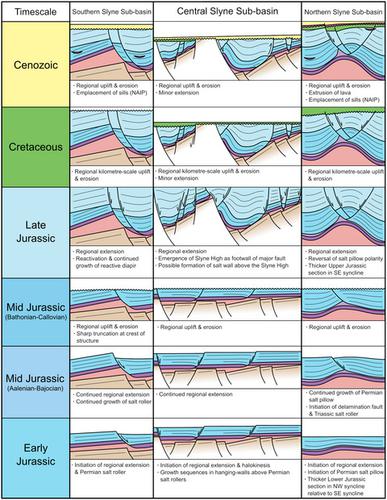当前位置:
X-MOL 学术
›
Basin Res.
›
论文详情
Our official English website, www.x-mol.net, welcomes your
feedback! (Note: you will need to create a separate account there.)
The influence of multiple salt layers on rift-basin development; The Slyne and Erris basins, offshore NW Ireland
Basin Research ( IF 2.8 ) Pub Date : 2021-01-27 , DOI: 10.1111/bre.12546 Conor M. O’Sullivan 1, 2 , Conrad J. Childs 1, 2 , Muhammad M. Saqab 1, 2, 3 , John J. Walsh 1, 2 , Patrick M. Shannon 1, 4
Basin Research ( IF 2.8 ) Pub Date : 2021-01-27 , DOI: 10.1111/bre.12546 Conor M. O’Sullivan 1, 2 , Conrad J. Childs 1, 2 , Muhammad M. Saqab 1, 2, 3 , John J. Walsh 1, 2 , Patrick M. Shannon 1, 4
Affiliation

|
In contrast to much of the European Atlantic margin, the influence of salt on basin evolution has received little attention to date in the basins west of Ireland, despite salt being proven in several boreholes. Using an extensive seismic reflection database coupled with data from exploration wells and shallow boreholes, this study maps the distribution and composition of salt layers and investigates their role in the structural evolution of the Slyne and Erris basins offshore west of Ireland. Two salt-prone intervals have been proven. The Upper Permian Zechstein Group is present throughout the Slyne and Erris basins, whereas the Upper Triassic Uilleann Halite Member is only developed in the Northern Slyne and Southern Erris sub-basins. Both sedimentary units mechanically detach pre-, post- and intra-salt stratigraphy. Both salt layers underwent halokinesis during basin development, creating a variety of salt-related structures. Salt pillows and salt rollers formed in the Zechstein Group, causing folding and rafting in the overlying Mesozoic section, driven by active faulting within the pre-salt basement. Halokinesis in the Uilleann Halite Member caused thin-skinned crestal collapse of the overlying Jurassic section above anticlines cored by Zechstein salt. Where both Triassic and Permian salt are present, unique structural geometries are formed when two stratigraphically discrete but kinematically linked halokinetic structures develop. The most common structural configuration consists of a Zechstein salt pillow and an Uilleann Halite salt wall separated by Lower Triassic sandstones. The fold axis of the salt pillow trends parallel to the strike of the salt wall. The results of this study provide a framework for the evolution of halokinetic structures in other basins on the Irish Atlantic margin, give a greater insight into the Permian and Triassic palaeogeography of the region and have more general implications for the evolution of salt-related structures in rift basins with multiple stratigraphically discrete salt layers.
中文翻译:

多个盐层对裂谷盆地发育的影响;西北爱尔兰近海的Slyne和Erris盆地
与欧洲大西洋边缘的大部分地区相比,尽管盐在多个钻孔中得到了证实,但迄今为止,盐对爱尔兰盆地西部盆地演化的影响很少受到关注。本研究使用广泛的地震反射数据库,结合勘探井和浅孔的数据,绘制了盐层的分布和组成图,并研究了盐层在爱尔兰西部近海Slyne和Erris盆地的结构演化中的作用。已经证明了两个容易发生盐蚀的时间间隔。上斯勒姆和埃里斯盆地遍布上二叠统Zechstein组,而上三叠纪Uilleann Halite成员仅在斯林北部和南埃里斯次盆地发育。两个沉积单元均将盐前,盐后和盐内地层机械分离。在盆地发育过程中,两个盐层都经历了盐碱化作用,形成了各种与盐有关的结构。Zechstein组中形成了盐枕和盐辊,在上盐中基底的活动断裂作用下,导致上覆中生界发生折叠和漂流。Uilleann Halite成员的Halokinesis导致以Zechstein盐为中心的背斜上覆侏罗纪剖面的薄皮地壳塌陷。当三叠纪盐和二叠纪盐同时存在时,当两个地层离散但运动学联系在一起的卤代动力学结构形成时,就形成了独特的结构几何形状。最常见的结构构造包括Zechstein盐枕和被下三叠纪砂岩分隔的Uilleann Halite盐墙。盐枕的折叠轴趋向于平行于盐壁的走向。这项研究的结果为爱尔兰大西洋边缘其他盆地的卤代动力学结构的演化提供了框架,对该地区的二叠纪和三叠纪古地理学有了更深入的了解,并对该地区盐相关结构的演化具有更广泛的意义。具有多个地层离散盐层的裂谷盆地。
更新日期:2021-01-27
中文翻译:

多个盐层对裂谷盆地发育的影响;西北爱尔兰近海的Slyne和Erris盆地
与欧洲大西洋边缘的大部分地区相比,尽管盐在多个钻孔中得到了证实,但迄今为止,盐对爱尔兰盆地西部盆地演化的影响很少受到关注。本研究使用广泛的地震反射数据库,结合勘探井和浅孔的数据,绘制了盐层的分布和组成图,并研究了盐层在爱尔兰西部近海Slyne和Erris盆地的结构演化中的作用。已经证明了两个容易发生盐蚀的时间间隔。上斯勒姆和埃里斯盆地遍布上二叠统Zechstein组,而上三叠纪Uilleann Halite成员仅在斯林北部和南埃里斯次盆地发育。两个沉积单元均将盐前,盐后和盐内地层机械分离。在盆地发育过程中,两个盐层都经历了盐碱化作用,形成了各种与盐有关的结构。Zechstein组中形成了盐枕和盐辊,在上盐中基底的活动断裂作用下,导致上覆中生界发生折叠和漂流。Uilleann Halite成员的Halokinesis导致以Zechstein盐为中心的背斜上覆侏罗纪剖面的薄皮地壳塌陷。当三叠纪盐和二叠纪盐同时存在时,当两个地层离散但运动学联系在一起的卤代动力学结构形成时,就形成了独特的结构几何形状。最常见的结构构造包括Zechstein盐枕和被下三叠纪砂岩分隔的Uilleann Halite盐墙。盐枕的折叠轴趋向于平行于盐壁的走向。这项研究的结果为爱尔兰大西洋边缘其他盆地的卤代动力学结构的演化提供了框架,对该地区的二叠纪和三叠纪古地理学有了更深入的了解,并对该地区盐相关结构的演化具有更广泛的意义。具有多个地层离散盐层的裂谷盆地。











































 京公网安备 11010802027423号
京公网安备 11010802027423号